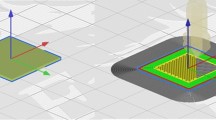Abstract
This paper introduces a method of replicating electrical circuits through a series of specific requirements as part of a design methodology referred to as Intrinsically Patterned Electrical Systems (IPES) processing methodology. IPESs are unique in that they allow for replication of a circuit directly using the circuit as a pattern for molding, without the use of an intermediate mold. In this study, the IPES processing methodology requirements have been met by using a set of specific mechanical manipulations and a combination of paraffin wax as a substrate and liquid gallium to form a conductive layer. The intent of the IPES methodology is twofold; it could be used for rapid, lower-cost manufacturing or in the repair of damaged printed circuit boards since the damaged circuit can be replicated through the mechanical manipulations detailed by IPES processing methodology requirements. Specifically, this paper investigates the possibility of IPES methodology to meet manufacturing requirements, which is demonstrated through the conducted computational fluid dynamics (CFD) studies. This paper also includes a short physical example of a simplistic circuit which is replicated using the IPES processing methodology.












Similar content being viewed by others
Availability of data and material
Data and material will be provided by John Cotter upon request.
References
Assael MJ, Armyra IJ, Brillo J, Stankus SV, Wu J, Wakeham WA (2012) Reference data for the density and viscosity of liquid cadmium, cobalt, gallium, indium, mercury, silicon, thallium, and zinc. J Phys Chem Ref Data 41(3):033101
Charles D (1925) Electrical apparatus and method of manufacturing the same. Google Patents US Patent 1:563,731
GoldPhoenixPrintedCircuitBoardCo.Ltd (2012) Cost analysis of printed circuit board. https://www.goldphoenixpcb.com/html/Support_Resource/capcb/arc_129.html. Accessed 04 Jan 2020
Hardy S (1985) The surface tension of liquid gallium. J Cryst Growth 71(3):602–606
Heckele M, Guber A, Truckenmüller R (2006) Replication and bonding techniques for integrated microfluidic systems. Microsyst Technol 12(10–11):1031–1035
iconnect007.com (2015) “World PCB Production in 2014 Estimated at $60.2B.“ IPC. http://www.iconnect007.com/index.php/article/92973/world-pcb-production-in-2014-estimated-at-602b/92976/?skin=pcb. Accessed 03 Jan 2020
Jones R, Haufe P, Sells E, Iravani P, Olliver V, Palmer C, Bowyer A (2011) RepRap–the replicating rapid prototyper. Robotica 29(1):177–191
Jordan B (2017) Designer adaptation in the changing PCB industry. EE Eval Eng 56(11):20–23
Kentzer J, Koch B, Thiim M, Jones RW, Villumsen E (2011) An open source hardware-based mechatronics project: the replicating rapid 3-D printer. In: 2011 4th International conference on mechatronics (ICOM), IEEE
McCormick E (2009) Easily duplicate decorative hardware. DIY Solutions
Mills M (2011) Hearing aids and the history of electronics miniaturization. IEEE Ann Hist Comput 33(2):24–45
Van Erps J, Wissmann M, Guttmann M, Hartmann M, Desmet L, Debaes C, Mohr J, Thienpont H (2008) Replication of deep micro-optical components prototyped by Deep Proton Writing. In: Micro-Optics 2008, international society for optics and photonics
Acknowledgements
Acknowledgments of people, grants, funds, etc. should be placed in a separate section on the title page. The names of funding organizations should be written in full.
Funding
This research was completely self-funded.
Author information
Authors and Affiliations
Contributions
Conceptualization: JC; Methodology: JC; Formal analysis and investigation: JC; Writing—original draft preparation: JC; Writing—review and editing: JW, RG; Funding acquisition: JC; Resources: JC; Supervision: RG.
Corresponding author
Ethics declarations
Conflict of interest
The authors declare that they have no conflict of interest.
Additional information
Publisher's Note
Springer Nature remains neutral with regard to jurisdictional claims in published maps and institutional affiliations.
Rights and permissions
About this article
Cite this article
Cotter, J., Wang, J. & Guldiken, R. Intrinsically patterned electrical systems: physical requirements and experimental demonstration. Microsyst Technol 27, 307–314 (2021). https://doi.org/10.1007/s00542-020-04954-y
Received:
Accepted:
Published:
Issue Date:
DOI: https://doi.org/10.1007/s00542-020-04954-y




